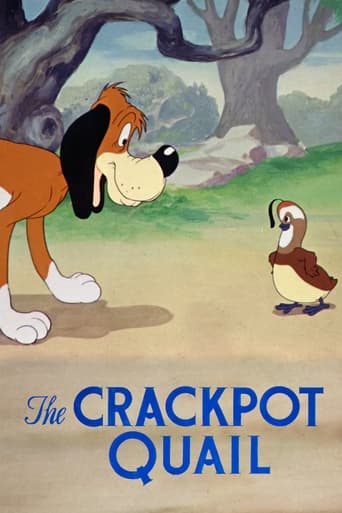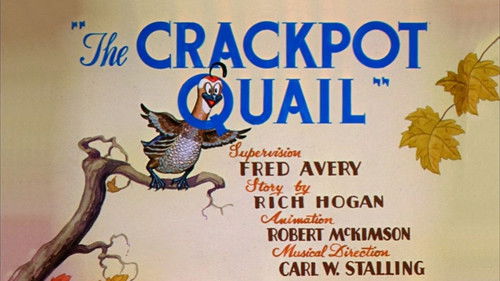ejumean
"The Crackpot Quail", a 1941 Merrie Melodies short, featuring Willoughby the dog (who had previously tussled with Bugs Bunny in "The Heckling Hare" in the same year) faces up against a cagey quail, whose main attributes are a top-knot that keeps falling in his face, and a loud whistle (which was supposedly changed from a raspberry noise in its original theatrical airing.) The quail sounds similar to Bugs, and adopts some of the same language (calling Willoughby "doc" for instance).The cartoon is of the standard predator-chases-prey variety, so it's not like it hasn't been done before (or since for that matter). A running gag throughout shows Willoughby unwittingly slamming into trees ("'Nother tree!") which leads up to the cartoon's conclusion. The cartoon reaches its climax with Willoughby chasing the quail at supersonic speed -- the animation is just his head with streaks indicating high speed, with the sounds of "The William Tell Overture" getting faster and faster as he ramps up his running speed. The quail ducks behind a tree, Willoughby rushes by, and we're led into I think the cartoon's centrepiece, a 25-second crash, quite possibly the longest in any animated cartoon. We don't see the dog, the camera pans behind him, as we view the destruction in his wake: A broken stone wall, small trees downed, a wrecked log cabin (though in my foggy memory of seeing this as a kid, I had thought it was a greenhouse that we panned by), a broken stove, a ruined outhouse and a whole heap of uprooted trees.We finally stop the pan at a huge pile of logs, where Willoughby appears from underneath, giving the final payoff: "Huh huh, lotsa trees!" and mimics the quail's whistle and the cartoon ends.Overall, it's a decent cartoon, with some good gags and a pretty decent payoff.
Edgar Allan Pooh
. . . (aka, those Animated Shorts Seers frequently referred to as the "Looney Tuners") did NOT need multiple brief cartoons to warn Americans of the (Then) Far Future of one of their upcoming Calamities, Catastrophes, Cataclysms, or Apocalypti. Take the case of the 44th U.S. Veep, or the dude known as James Danforth "Danny" Quayle. This typical specimen of the Deplorable Red State Confederate Repug Rich People's Party hailed from Paradise Valley, AZ, as pictured throughout THE CRACKPOT QUAIL. When he wasn't busy teaching America's school kids to misspell various words (such as his infamous Idaho "Potatoe"), Quayle spent most of his time as America's most vacuous Veep ever making annoying whistling sounds, as heard during THE CRACKPOT QUAIL. Danny Quayle was in line to become President of Trump University just before the FBI cracked down upon that fraudulent institution of Fake Learning. (This well-document bust is forecast for America about 75 years in advance, as Willoughby the hound trashes the Trump\Quayle gang's bogus brainwashing shack at the end of THE CRACKPOT QUAIL).
hershey1174
Okay, so Tex Avery's "The Crackpot Quail" was released the same year as "The Wild Hare" and featured an animal protagonist facing a less-than-brilliant antagonist, addressed by the animal protagonist throughout as "Doc." So the plot features not a great deal more than a dog in pursuit of the quail in hopes of achieving his dream as a Pointer. So neither the dog nor the quail really achieved the status throughout pop history as the likes of Elmer Fudd and Bugs Bunny.All of this can easily be forgiven, and is saved, by two key elements: the brilliant animation of Bob McKimson (easily one of Warner Brothers' best animators of all time, yielding stronger work as an animator than as a director imo) and the terrific-as-always score by Carl Stalling. Both of these two elements blend into a great marriage of expression: we are well aware of the emotions at all times of protagonist and antagonist alike.McKimson manages to achieve a great deal of this for Avery's title character through his decidedly unwieldy black top; we are introduced to the character as we see the top fly up several times in time to its soon-to-be familiar whistle before a pan down shows that the obscured bird has been attempting to blow it out of its eyes. The black top soon shows us a great deal of emotion: at one point, when the bird is submerged in water and encounters the dog, we see the top transform from a submarine telescope to the shape of a question mark! A bit later, in a moment of particular distress, when the quail is trapped, the top suddenly sprouts into a series of spikes that would make a porcupine proud.The dog also has a fine moment of emotional expression, highlighted in no small way by Stalling's score. When he comes to the realization that his prey has duped him into a game of fetch, a series of short piano crescendos reveal his realization, and McKimson shows the pro he is at the expression of sheer fury through two major facial features: the eyes and the teeth, the latter of which clench so tightly that the stick inevitably breaks. Though he does point out the obvious, true to his character, the dog need not inform us that he's "getting' plenty sore!"; McKimson has helped us to understand that well enough."The Crackpot Quail" might not have been a candidate for the Oscar. It might not have spawned any great recurring protagonists or series per se, though plenty of "dumb dogs" cropped up in Warner Brothers animation since the release of this cartoon. But it definitely deserves a bit of recognition, and is well worth a look. Not for anything particularly great, but for the smaller elements that are often overlooked.
bob the moo
A dog is out in the countryside when he starts to get hungry. He decides to try and catch himself a nice plump quail but, even after he finds one, she turns out to a much trickier prey than he had originally thought.Every now and again with WB cartoons, I'll come across some with totally new characters - they are usually pretty anonymous dogs, cats or mice. Generally they go through the material that the more established characters will do in their shorts. That is the case here - the quail basically plays Bugs Bunny, right up to the fact that she calls the dog `doc'! The dog just plays the foil character and he is actually OK.The material is quite amusing, the quail tricks and fools the dog in the time honoured fashion of Bugs Bunny and the dog has a few good lines in his running joke. However it is very hard to shake the feeling that we've seen this done better somewhere else, and the feeling that the characters are pretty pale imitations of better characters. I'm at a loss as to why anyone would even have the quail use `doc' in her dialogue - why make it so obvious that she's just a bird version of Bugs?Overall this is still reasonably enjoyable, but you'll not be able to stop thinking about how much fun Bugs Bunny can be, long after the quail has gone from your memory.



